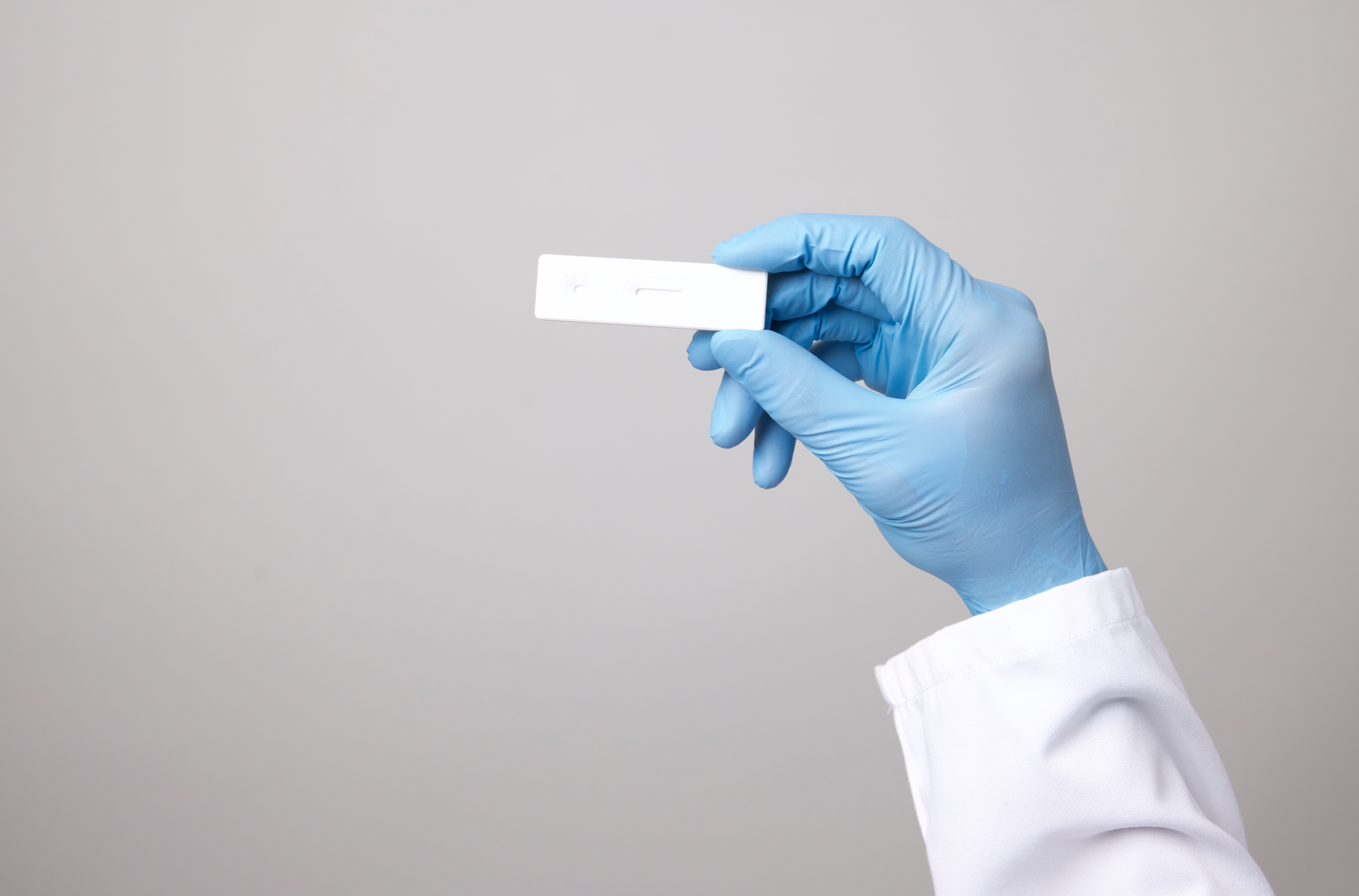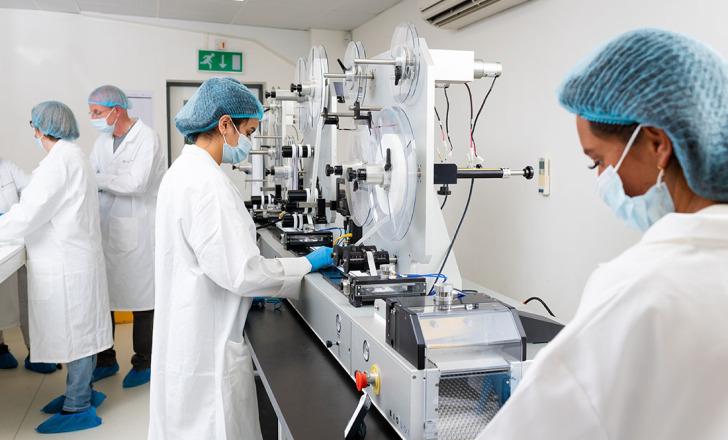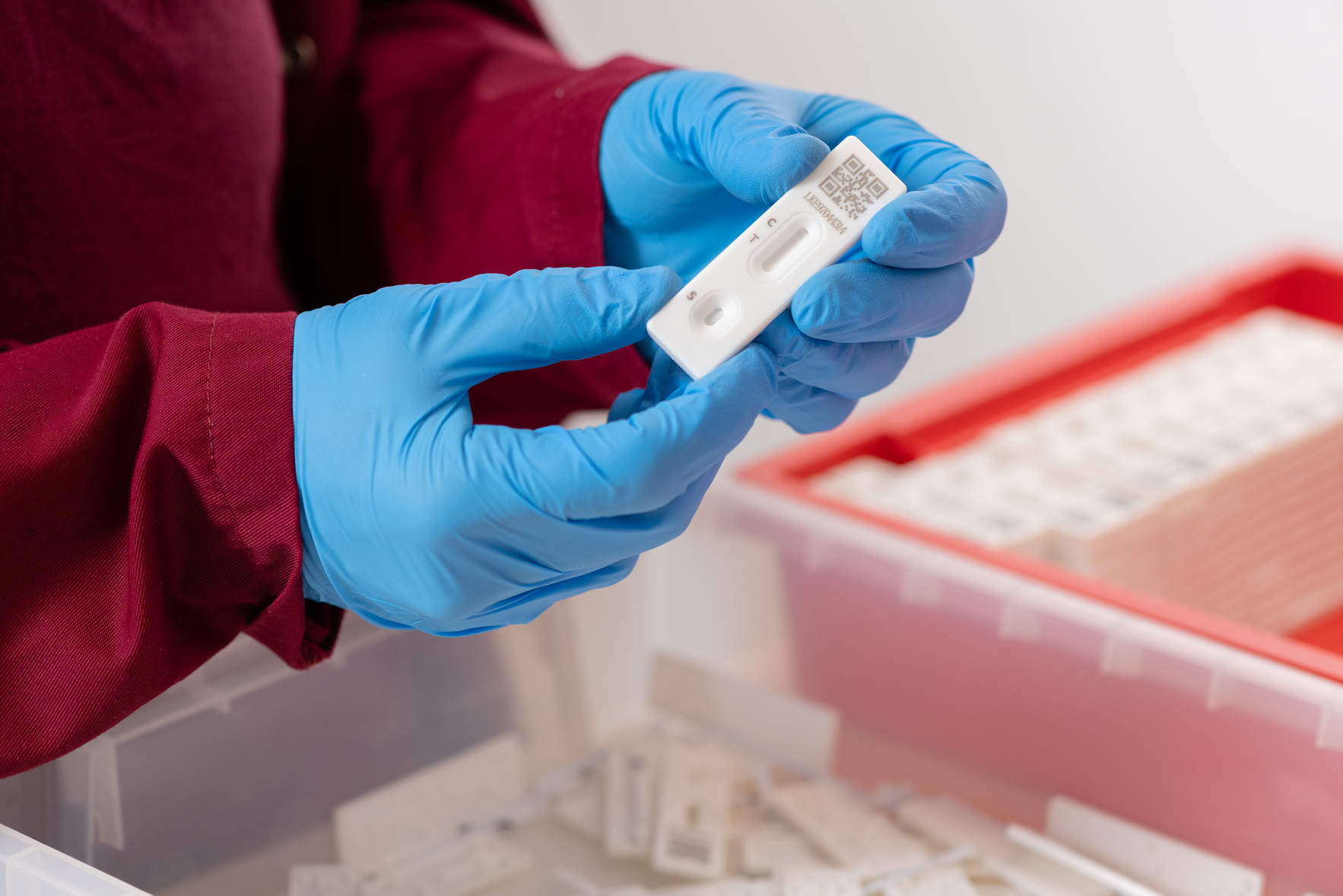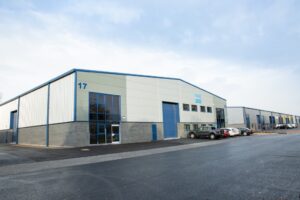In the Lab: Research & Development with George Newham
George Newham is a Research and Development Scientist at Surescreen, where he is instrumental in the development and production of rapid lateral flow devices (LFDs).

Specialising in nanoparticle physics, George manufactures the tiny pieces of metal – 1000 times smaller than a human cell – that are integral to LFDs detecting diseases and displaying a visual result. Here, he describes the science behind LFDs – and their potential impact on the future of medical diagnostics.
Lateral flow tests have been a significant medical diagnostic tool for some time now; the most common form of pregnancy test has been a lateral flow device since 1988. Even so, it wasn’t until the COVID-19 pandemic in 2019 that LFDs became a near-universal part of daily life and the concept of self-testing burst into the public consciousness on a major scale. One of the very few positives to come out of the pandemic is that we have been altered en masse to how effective a tool LFDs can be for disease testing – providing rapid, reliable results without needing to be performed by trained medical professionals.

At Surescreen, the main thing we are trying to do is develop new tests for diseases beyond COVID-19, improve the sensitivity of tests so we are able to detect diseases better or earlier, and essentially increase the range of things we are able to accomplish using LFDs. My role as a Research and Development Scientist is to produce the tests themselves – all the way from doing the background chemistry and physics, through to spraying chemicals onto the strips of paper that are then packaged up within the plastic testing cassettes.
The first stage of research and development is disease targeting, which means choosing a disease with a suitable medical and business case for detection. At this point, we would be consulting and collaborating with colleagues from other medical fields – the NHS, academics, consultants and so on – to identify diseases that would benefit most from a rapid test. Those would potentially be diseases for which you need to get results quickly so that you can come up with a good treatment plan straight away, but where current testing takes a long time. Alternatively, we might be looking at diseases for which you might face regular screening once you hit a certain age category that puts you at greater risk. Any disease that creates a high input of tests and large workload for testing labs is a potential area of interest that could benefit from people taking rapid tests at home.
Once we’ve identified a target disease, the next stage is to obtain the antibodies that we use to develop the LFDs. In the most basic sense, an antibody is effectively a small grabber that your body produces as part of an immune response, and it will specifically bind onto another molecule – in this case a virus, bacteria, protein or similar. We spray these antibodies onto the ‘test’ line of the LFD, so that as the sample liquid flows past they will ‘grab’ onto the virus (if present). At the same time, there are also some very small bits of gold – the nanoparticles that I make – which have a corresponding antibody on them that ‘grabs’ onto the virus. The gold is coloured bright red, so if the virus is present, the gold antibody then sticks to the ‘test’ line along with the virus – giving the bright red line that indicates you have tested positive. If the virus isn’t present, the gold flows past so that there is no colour sticking to the test line – a negative result.
One of the biggest challenges during the R&D stage is achieving the correct level of specificity. Success depends on your antibody being able to pick out one – and only one – marker. Taking the COVID test as an example, you need to be extremely sure it’s only detecting COVID, and not also colds and flu. This means that whenever we pick a new target, we need reliable antibodies in order to make sure that the test we make is incredibly specific to the one marker that we’re looking for. Once we have achieved the desired level of specificity, it is then absolutely vital to test and validate our product before sending anything out, to ensure that we are achieving our goal of providing an accurate diagnosis.

Part of this process involves providing extremely clear guidelines about how the tests should be used, and situations in which the tests are and are not accurate. To establish this – again using COVID tests as an example – we would purchase a ‘control solution’ that contains a known concentration on the COVID-19 virus within some fake saliva – a simulated ‘positive’ case, effectively. We would then line up a large number of tests in the lab, and then drip different concentrations of the solution on to establish when we get a result and when we don’t – thereby providing us with a preliminary idea of the limit of detection, and whether this matches up with what’s required in medical practice.
Once we’re satisfied with those results, we would progress to clinical trials in partnership with NHS trusts, providing them with a number of our tests which they can then use to run the same samples that they are testing with the top-of-the-range machines in their high-tech laboratories. So essentially, the results from our LFDs would be compared with the results from the most advanced lab machines available, and we would then be able to look at the outcomes and establish the accuracy of our product compared to their normal testing methods. Aiming for an accuracy of at least 99%, we would get feedback on our false negative and positive rates, and having built up a big enough body of evidence, then go back and make tweaks and improvements to our LFDs before finally submitting them for approval.
There will always be limitations to LFDs, but in theory – assuming we can get hold of an antibody that will pick out the specific virus, infection or marker of cancer, for example – we could develop a test for virtually any disease or condition. Broadly speaking – and as briefly touched on above – there are two categories for which it would be particularly useful to develop LFDs. The first includes those situations where you go to the doctors with something potentially very urgent and damaging, and because it would take too long to receive the test results the doctor has to treat you for a worst-case scenario, starting you on an intensive and expensive treatment programme. In this case, a rapid lateral flow test would enable you to triage much more quickly and help better inform the treatment direction.

The second category involves those lower-risk but abundant problems which take up a huge amount of laboratory testing resources – resources which, if freed up, would enable them to address higher-risk and perhaps more niche diseases more quickly. Let’s say there is a run-of-the-mill problem that could realistically be dealt with without a GP, and you could instead speak to a pharmacist who would give you a test to carry out in your own home. You could then report the result back to your GP or pharmacist, and they would prescribe you the appropriate drug. GPs deal with hundreds of these sorts of run-of-the-mill problems all the time; freeing them, other medical professionals and lab spaces up from dealing with such minor issues would enable them to devote more time to dealing with less common or more challenging cases.
The future of diagnostics is about putting power into patients’ hands and enabling them to test themselves. There should be no need to go and see a GP in person if it isn’t necessary and you are able to obtain a very high level of accurate diagnosis without doing so. This level of convenience and efficiency would extend to regular screening tests for conditions that you are at higher risk of developing in old age for example; instead of having to travel to a clinic and get your sample sent to a lab, those tests could be carried out much more quickly and easily in your own home.
This sort of rapid testing would also widen the scope for providing health care to those areas of the world that lack sufficient access to high-quality laboratories and highly trained scientists. At the moment, patients in certain areas of the developing world don’t have many options when it comes to obtaining a diagnosis for diseases, but if we can make access to diagnosis cheaper and not dependent on technology – to the point where you can have a single enclosed package that contains a LFD – then disease diagnosis need not be tied to wealth or resources in the future. That would bring us one step closer to the dream of most – if not all – diseases being diagnosable for everyone, wherever they might be in the world.
This isn’t going to happen tomorrow; this is the big picture of what we would really like to achieve. There will always be diseases which you can’t diagnose with LFDs for whatever reason, and there will also always be reasons that patients will need to see doctors in person. But the pressures we see today – not just on the NHS, but on the whole of society – seem likely to increase. The more we give people the option of testing at home – or at patients’ bedsides in care homes, or wherever might be most suitable – the more we can hopefully free up time for medical staff to see patients who are most in need of face-to-face contacts, free up laboratory time for testing serious and niche diseases, and ensure health systems are optimally prepared to continue providing high-quality care in the face of increasing demand.
More stories from Surescreen
View all articlesStay up to date with all of SureScreen's latest news, products and services.




